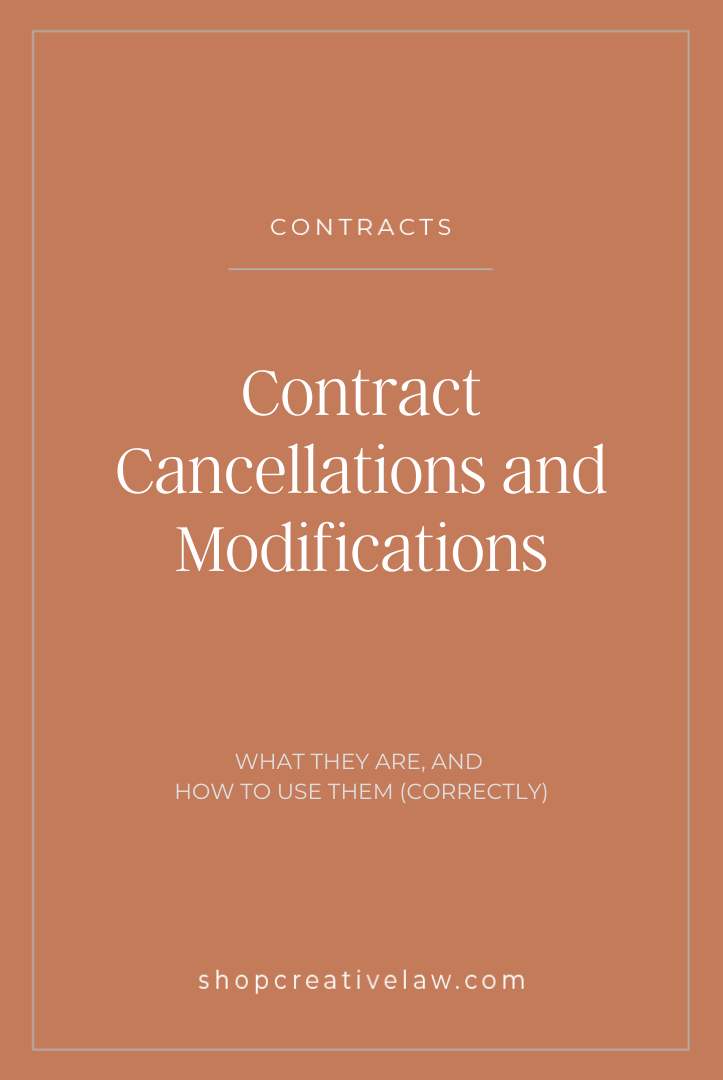Get to Know Contract Cancellations and Modifications
What They Are, And How To Use Them (Correctly)
2020 has taught us, business owners, many lessons I’m sure, none of us will forget...one of which is the importance of maintaining a level of professionalism and flexibility, so that your business is able to deftly jump through the hoops that the unexpected (like a global pandemic) can throw at us, without harming our client relationships in the process.
But when we have ironclad client agreements in place, how do we provide the flexibility that our clients may sometimes require? In other words, how do we maintain the integrity of our contracts, while also accommodating our clients’ fluctuating needs?
This is a question that we may have to ask ourselves a time or two in “normal” years. We weigh how flexible we can be as certain questions pop into our inbox, one person may ask for a schedule change, another for a change in the scope of service. But in “normal” years, we expect these questions to come from a client or two, not our whole calendar. In typical 2020 fashion, this year has been different. With a global pandemic at play, in many (most) circumstances, both the client and the vendor require changes to the contracts. But what exactly can those changes look like, and how exactly do you go about implementing one, legally?
So first things first: let’s discern if you need an amendment or an addendum. And while they sound so similar, they have very different legal outcomes.
A contractual amendment
An amendment alters the original terms of the original contract in one way or another. In other words, it replaces something (usually a minor detail) already agreed to by the parties. An amendment attaches to the original contract after the original has already been signed. For example: did your client’s wedding date change? Attach an amendment to the original, specifying the new date of the wedding. Are you a product maker? An amendment refers to changes made before the contract comes to fruition (the product is sent or delivered to the client); a modification is the term for any change made after the contract comes to fruition.
A contractual modification
A modification is a change to one or more terms of the contract, in the fact that it introduces new elements into the details or cancels some of the details but leaves the general purpose and effect of the contract intact. The key difference between this and amendments is that modifications agree to alter a contractual provision, but the overall nature remains unchanged.
For example, this has occurred very often in the wedding industry in light of COVID-19. In the spring, many wedding professionals had to scramble to accommodate new wedding dates, and most had some sort of additional term thrown in such as a rescheduling fee, additional COVID precautions to be implemented, etc. Many contractual disputes that wound up in court centered around the question of whether or not a request for a full refund was a cancellation or just a contractual modification.
So, how do you execute each properly?
First and foremost, always look to see what your contract has to say about amendments or modifications. Your contract governs your specific circumstance.
Modifications:
A modification of a contract requires the mutual assent of both, or all, parties to the contract, to both the modification itself, and the meaning of the modification - a legal “meeting of the minds” of the parties - which must be spelled out, either expressly or impliedly, with sufficient definiteness. Also, parties may alter any term of an existing contract by entering into a subsequent contract, and the contract, as modified, becomes a new contract between the parties, and the meaning to be given the subsequent agreements depends on the intention of the parties (Findlaw).
Amendments:
Formatting: It is recommended that you overtly show any changes to the original contract by using track changes, redlines, or strikethroughs of the text. Typically, additions are illustrated with underlined text, and stricken text is crossed out. Most word processing programs have a strikethrough option. Directly before the amended section, include clarification about the amendment process and which section is to be modified. For example: "The parties agree to amend Section 10 of the Agreement with these additions (marked by underlining) and deletions (marked by strikethroughs): Section 10 is amended to read as follows:"
Replacement: Amendments can occur by replacing an entire paragraph or clause. Indicate the clause that is being removed and add the new information in its place.
Description: Amendments can also occur by amending a specific description or a portion of a clause. Clearly describe which information is being replaced in the amendment. For example: "The event date in the first sentence of the first paragraph is being modified from January 1st, 2022, to February 1st, 2020.”



